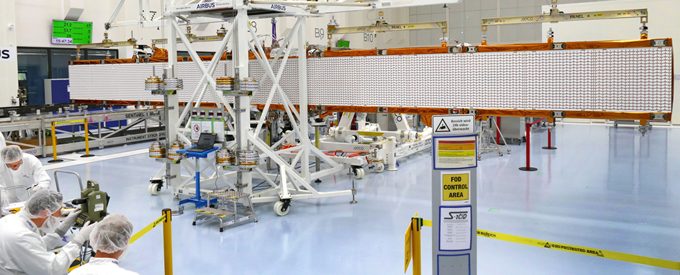2020-09-01
Sentinel-1C Radar Spreads its Wings
The radar antenna of the Copernicus Sentinel-1C satellite has successfully spread its wings at the Airbus Integrated Technology Centre in Friedrichshafen, Germany for the first time in August. The 12.3-metre-wide and 860 kg SAR (Synthetic Aperture Radar), was fixed to a special device and simulating zero gravity conditions.
Sentinel-1C is the third of the Sentinel-1 radar satellite series and will ensure data continuity for the many services offered by the EU’s Copernicus programme. The Sentinel-1C satellite equipped with the SAR Instrument (C-band radar) will provide radar images of the entire Earth’s surface as part of the Copernicus programme funded by the European Union and the European Space Agency (ESA).
These radar images will be used across many areas of Earth observation including monitoring Arctic sea-ice, routine sea-ice mapping, surveillance of the marine environment, monitoring land-surface for motion risks, forest mapping, water and soil management, and to support humanitarian aid and disaster monitoring.
The antenna consists of a centre panel, which will be fixed to the satellite platform and two deployable antenna wings with two panels each. The unfolding test was to check the correct deployment of these two wings and to measure the planarity of the antenna as an indicator for the future SAR image quality.
Supporting the Environment
Next step in the acceptance test sequence of the SAR instrument (complete antenna with the antenna electronic subsystem built by Airbus Portsmouth, UK) is a functional and performance test campaign, planned to run until the end of October. Post that the antenna’s radio frequency characteristics will be checked before the instrument is shipped to Thales Alenia Space for platform integration. Copernicus Sentinel-1C is set for launch in 2022.
Thales Alenia Space is prime contractor for Sentinel-1C and its twin Sentinel-1 D. Airbus Defence and Space is responsible for both radars. The Sentinel-1C and 1D satellites, to be launched as from 2021, are part of the Copernicus environmental monitoring and management programme coordinated by the European Commission, with ESA in charge of the space segment. The Copernicus programme is designed to guarantee European independence in the collection and management of data on Earth, and to support Europe’s public environmental policies.
The Sentinel-1C and D satellites will each weigh about 2,300 kilograms at launch and will be positioned at an altitude of 700 kilometres, offering a ground resolution of 5 to 25 metres, depending on the operating mode selected.


No Comments